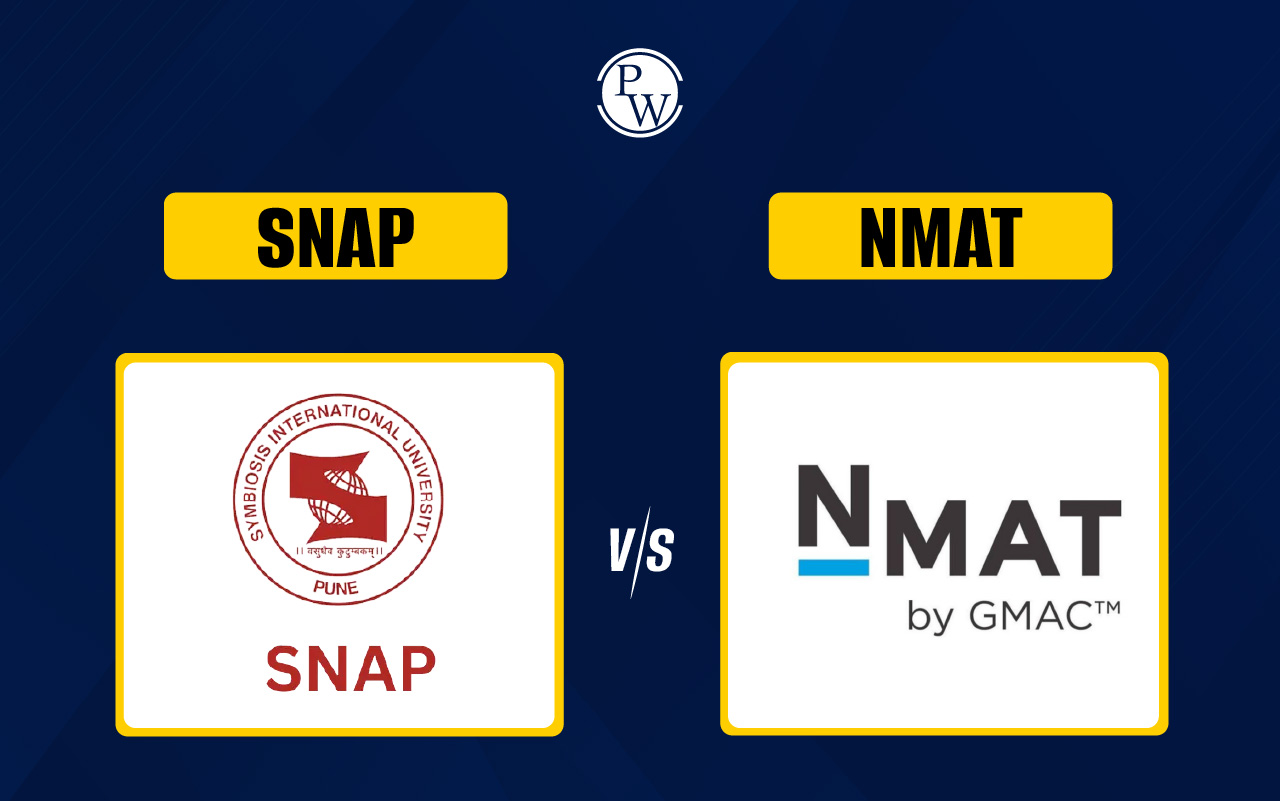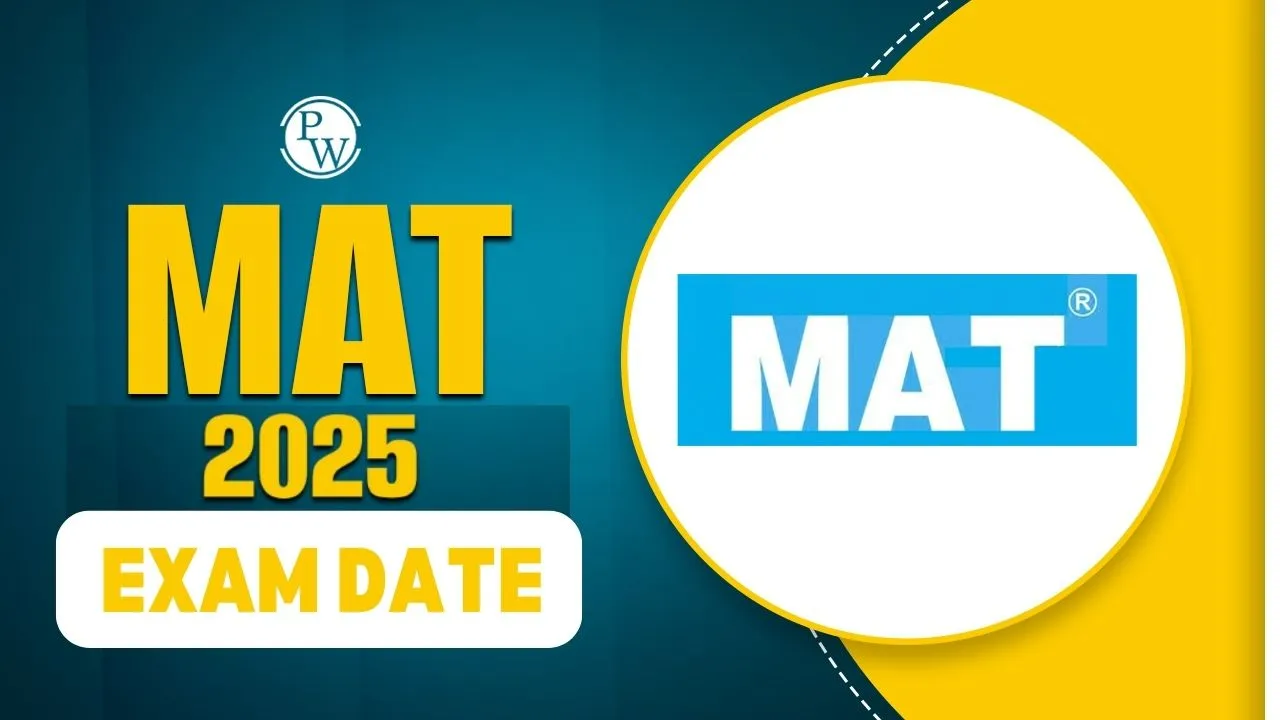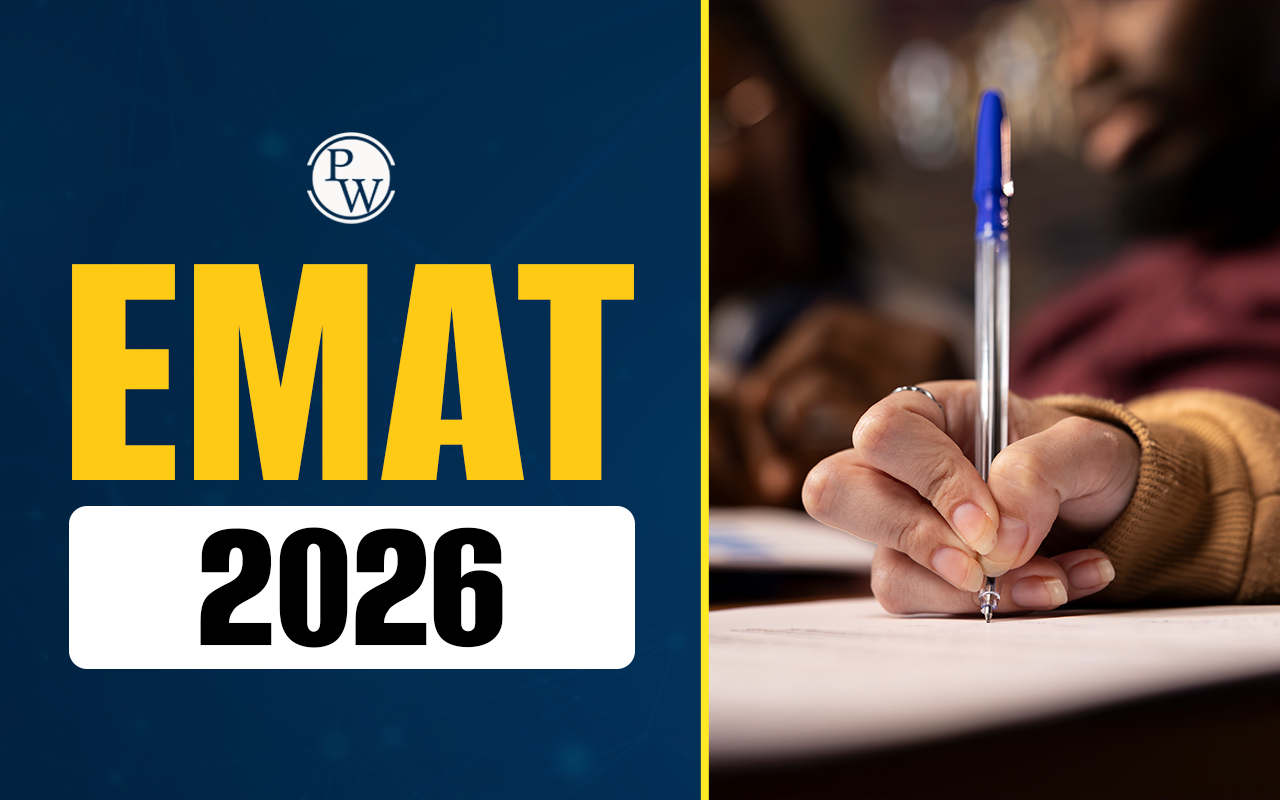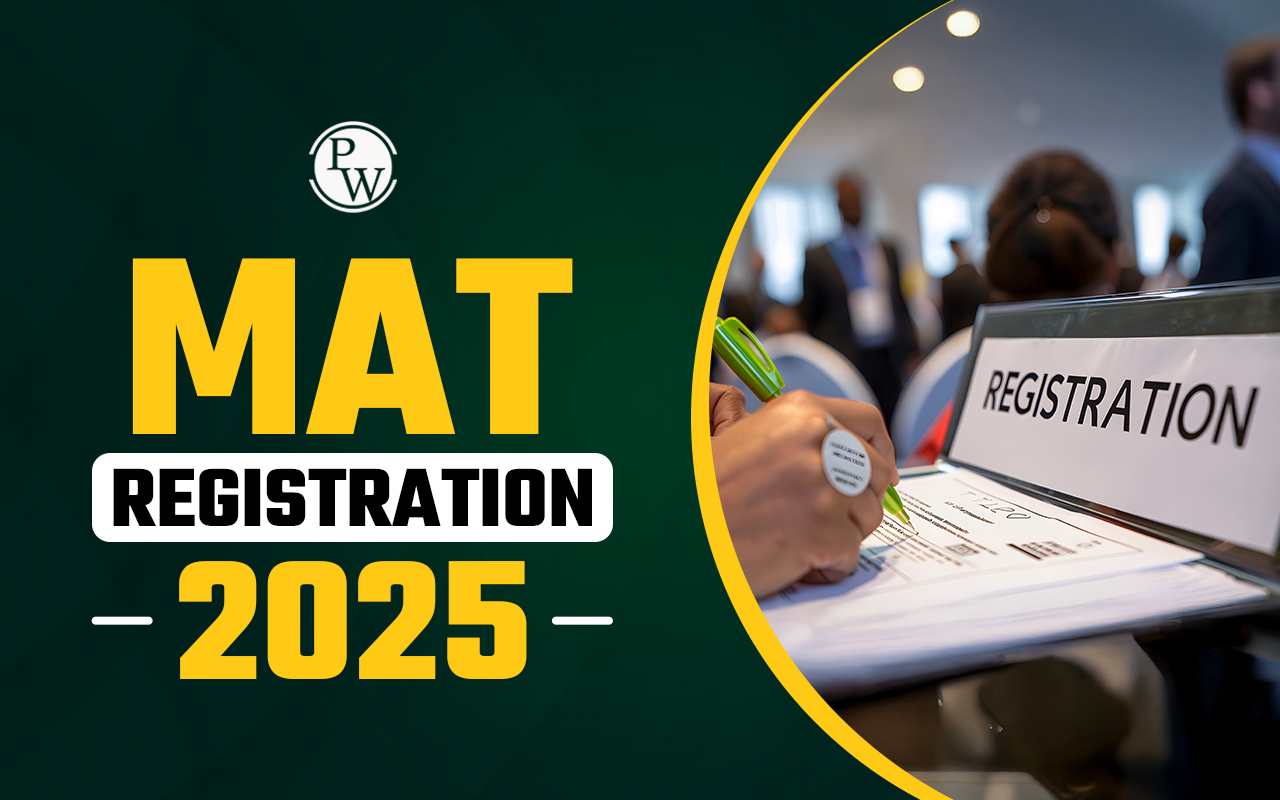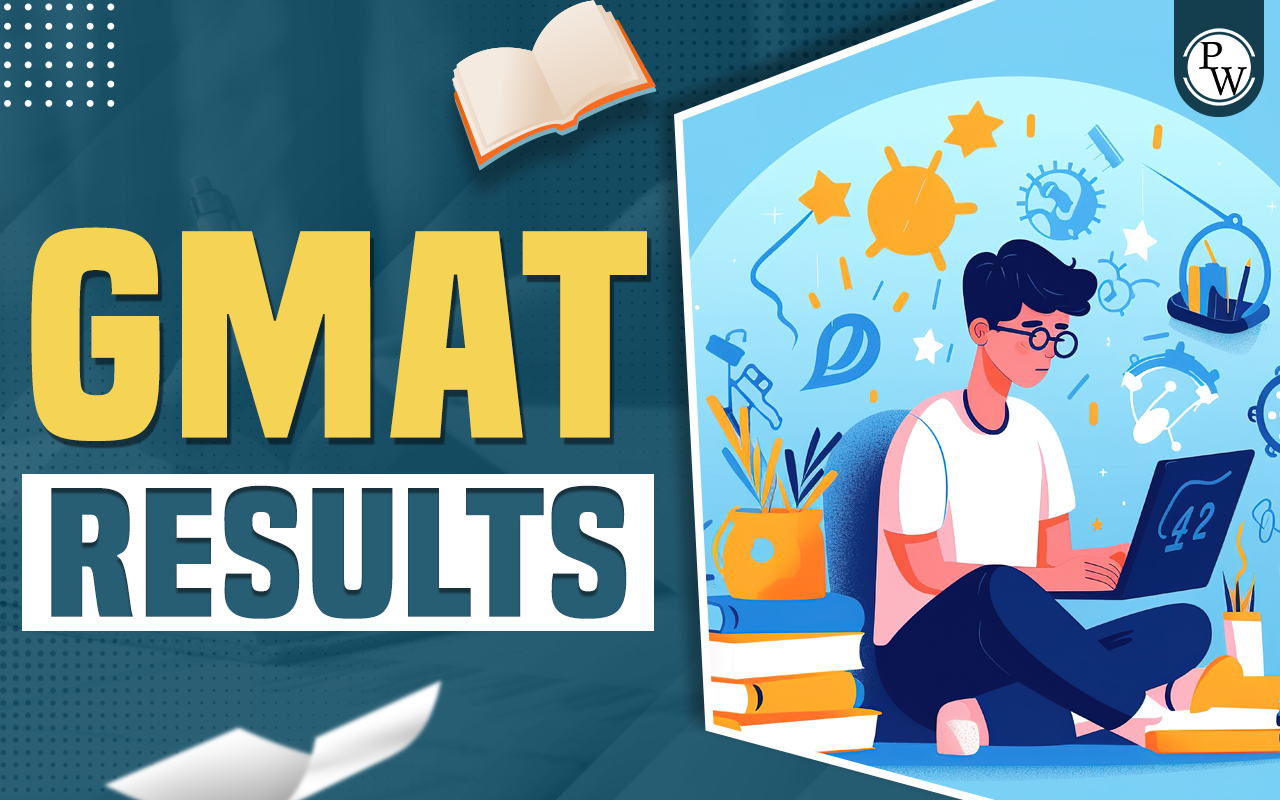
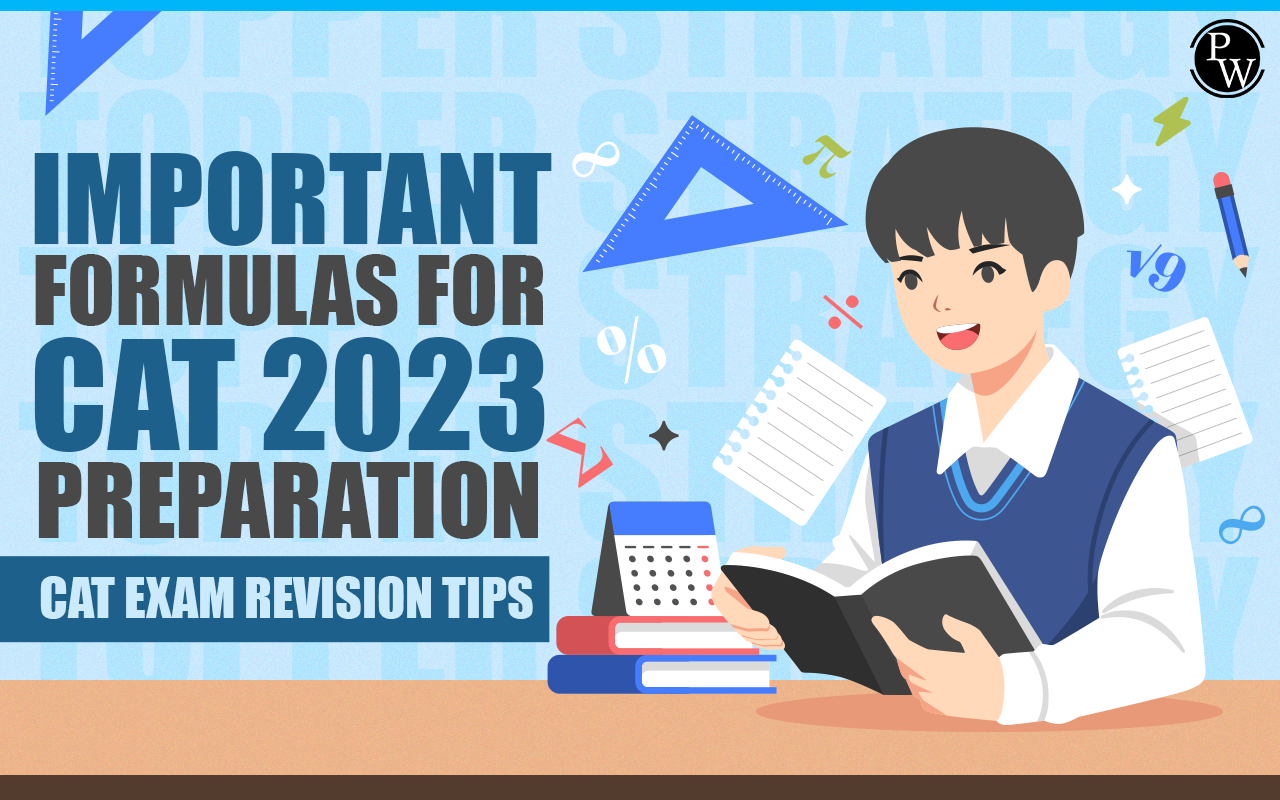
Important Formulas for CAT Preparation : Formulas play a vital role in CAT exam readiness. Let's explore the importance of CAT formulas and dive into the essential formulas you need for the CAT 2023 Quantitative Aptitude (QA) sectio n. Mastering these formulas and their application is key to solving CAT questions swiftly and accurately.
List of Important formulas for CAT 2023 preparation:
Here's a handy list of important formulas for CAT 2023 preparation that can help you conquer the quantitative aptitude part of the exam:Probability:
- PE=n(E)/n(S), where n(E) = favorable outcomes, and n(S) = total outcomes.
Profit, Loss, and Discount
- Profit Percentage = (Profit/Cost Price) x 100
- Loss Percentage = (Loss/Cost Price) x 100
- Selling Price = Cost Price + Profit
- Selling Price = Cost Price - Loss
- Cost Price = Selling Price - Profit
- Cost Price = Selling Price + Loss
- Profit = Selling Price - Cost Price
- Loss = Cost Price - Selling Price
- Discount = Marked Price - Selling Price
- Discount Percentage = (Discount/Marked Price) x 100
- Marked Price = Selling Price/(1 - Discount Percentage/100)
- Marked Price = Cost Price/(1 - Profit Percentage/100)
LCM and HCF
- HCF × LCM = Product of the two numbers.
- LCM of co-prime numbers = Product of the numbers.
- HCF of co-prime numbers = 1.
- HCF of two numbers a and b = HCF of (a-b, b).
- LCM of two numbers a and b = (a x b) / HCF(a, b).
- HCF of three numbers a, b, and c = HCF of (HCF(a, b), c).
- LCM of three numbers a, b, and c = LCM of (LCM(a, b), c).
Time and Work
- Work Done = Time Taken × Rate of Work
- Rate of Work = 1 / Time Taken
- Time Taken = 1 / Rate of Work
- If a piece of work is done by A in n days, then A's 1 day's work = 1/n
- If A's 1 day's work = 1/n, then A can finish the work in n days
- If A can do a piece of work in x days and B can do the same work in y days, then the work done by both A and B in one day = 1/x + 1/y
- If A can do a piece of work in x days and B can do the same work in y days, then the time taken by both A and B to complete the work together = (xy) / (x + y)
Averages
- Average = (Sum of observations) / (Number of observations)
- If the average of n numbers is A, then the sum of the n numbers is nA.
- If the average of n numbers is A and m more numbers are added to the list, then the new average becomes (nA + mB) / (n + m), where B is the average of the m numbers.
- If the average of n numbers is A and each number is increased by x, then the new average becomes (nA + nx) / n.
- If the average of n numbers is A and each number is decreased by x, then the new average becomes (nA - nx) / n.
Logarithm
- Definition of a logarithm: If x>0 and b is a constant (b≠1), then y=logbx if and only if x=by.
-
Logarithmic identities:
- logb(xy) = logbx + logby
- logb(x/y) = logbx - logby
- logb(x^p) = p logbx
- logb1 = 0
- logbb = 1
- logb(x) = 1 / logx(b)
- Change of base formula: logb(x) = loga(x) / loga(b)
- Common logarithm: log10(x) = log(x)
- Natural logarithm: loge(x) = ln(x)
Surds and Indices
- Product rule: a^m × a^n = a^(m+n)
- Quotient rule: a^m / a^n = a^(m-n)
- Power rule: (a^m)^n = a^(m×n)
- Negative exponent rule: a^(-m) = 1 / a^m
- Rational exponent rule: a^(m/n) = nth root of a^m
- Fractional exponent rule: a^(p/q) = qth root of a^p
- Surds multiplication rule: √a × √b = √(ab)
- Surds division rule: √a / √b = √(a/b)
- Surds addition rule: √a + √b ≠ √(a+b)
- Surds subtraction rule: √a - √b ≠ √(a-b)
Set Theory & Function
- De Morgan's Law: (A ∩ B)' = A' U B' and (A U B)' = A' ∩ B'
- Cardinality of a set: The number of elements in a set is called its cardinality.
- Union of sets: A U B = {x: x ∈ A or x ∈ B}
- Intersection of sets: A ∩ B = {x: x ∈ A and x ∈ B}
- Complement of a set: A' = {x: x ∉ A}
- Difference of sets: A - B = {x: x ∈ A and x ∉ B}
- Cartesian product of sets: A × B = {(a, b): a ∈ A and b ∈ B}
Trigonometry
- Sine = Opposite/Hypotenuse
- Cosine = Adjacent/Hypotenuse
- Tangent = Opposite/Adjacent
- Secant = Hypotenuse/Adjacent
- Cosecant = Hypotenuse/Opposite
- Cotangent = Adjacent/Opposite
-
Sum and Difference Formulas:
- sin(u + v) = sin(u)cos(v) + cos(u)sin(v)
- cos(u + v) = cos(u)cos(v) – sin(u)sin(v)
- sin(u – v) = sin(u)cos(v) – cos(u)sin(v)
- cos(u – v) = cos(u)cos(v) + sin(u)sin(v)
-
Reciprocal Identities:
- cosec θ = 1/sin θ
- sec θ = 1/ cos θ
- cot θ = 1/tan θ
- sin θ = 1/cosec θ
- cos θ = 1/sec θ
- tan θ = 1/cot θ
Coordinate Geometry
- Distance Formula: The distance between two points P(x1, y1) and Q(x2, y2) is given by √[(x2 - x1)^2 + (y2 - y1)^2].
- Slope Formula: The slope of a line passing through two points P(x1, y1) and Q(x2, y2) is given by (y2 - y1) / (x2 - x1).
- Equation of a Line: The equation of a line passing through a point (x1, y1) with slope m is given by y - y1 = m(x - x1) or y = mx + (y1 - mx1).
- Midpoint Formula: The midpoint of a line segment joining two points P(x1, y1) and Q(x2, y2) is given by [(x1 + x2) / 2, (y1 + y2) / 2].
- Section Formula: If a point R(x, y) divides the line segment joining two points P(x1, y1) and Q(x2, y2) in the ratio m:n, then x = [(nx2) + (mx1)] / (m + n) and y = [(ny2) + (my1)] / (m + n).
- Slope of a Parallel Line: The slope of a line parallel to a line with slope m is also m.
- Slope of a Perpendicular Line: The slope of a line perpendicular to a line with slope m is -1/m.
Mensuration
- Area of a triangle = 1/2 × base × height
- Area of a rectangle = length × breadth
- Area of a square = side × side
- Area of a parallelogram = base × height
- Area of a trapezium = 1/2 × (sum of parallel sides) × height
- Circumference of a circle = 2πr
- Area of a circle = πr^2
- Volume of a cube = side^3
- Surface area of a cube = 6 × side^2
- Volume of a cuboid = length × breadth × height
- Surface area of a cuboid = 2(lb + bh + hl)
- Volume of a cylinder = πr^2h
- Surface area of a cylinder = 2πrh + 2πr^2
- Volume of a sphere = 4/3 × πr^3
- Surface area of a sphere = 4πr^2
Number Systems
- Sum of first n natural numbers = n(n+1)/2
- Sum of squares of first n natural numbers = n(n+1)(2n+1)/6
- Sum of cubes of first n natural numbers = [n(n+1)/2]^2
- Sum of first n odd numbers = n^2
- Dividend = (Divisor x Quotient) + Remainder
Sum of Series
- 1 + 2 + 3 + ... + n = n(n + 1)/2, and more.
Geometry
- Area of sector, Cube Volume, Surface Area, Diagonal, Volume of cuboid, and more.
How to Memorize the Important Formulas for CAT 2023?
Remembering the important formulas for CAT 2023 might sound tough, but here are some simple tips to make it easier:- Get the Idea : First, understand why the formula works. When you know the logic behind it, it sticks in your memory better. So, try to grasp the reasoning and practice it regularly.
- Practice a Lot : Regular practice is key. Keep using these formulas by solving problems with them. This helps you really understand and remember them for a long time.
- Flashcards Are Handy : Make flashcards with the formulas and look at them regularly. Flashcards are like quick reminders that help you remember the formulas faster.
- Use Memory Tricks : Try using memory tricks or mnemonics. These are like little shortcuts that make it simpler to recall the formulas.
- Keep Going Over Them : Regular revision is super important. It reinforces your memory and makes sure you don't forget the formulas over time.
- Mock Tests Help : Do practice tests often. They not only test what you know but also show you where you might need more practice.
Effective Memorization Techniques for Learning Important Formulas for CAT 2023
To excel in mastering the crucial formulas needed for CAT 2023, several effective memorization strategies prove beneficial. These encompass gaining a deep understanding of the formula's underlying concept, ensuring consistent and frequent practice, utilizing flashcards as helpful aids, employing mnemonic devices to aid recall, maintaining a regular revision schedule, actively engaging with mock tests for evaluation, and employing a methodical approach of breaking down complex formulas into manageable segments for comprehensive comprehension. By diligently applying these techniques, candidates can enhance their formula retention, ultimately leading to improved performance in the quantitative aptitude section of the CAT exam.Mnemonic Devices Which Helps to Remember Important Formulas for CAT 2023?
Here are some handy memory tricks that can help you remember important formulas for CAT 2023:- SOHCAHTOA : Use this one for trigonometry – Sine = Opposite / Hypotenuse, Cosine = Adjacent / Hypotenuse, and Tangent = Opposite / Adjacent.
- C. HOPKiN’S Ca Mg : Remember the essential macronutrients – Carbon, Hydrogen, Oxygen, Phosphorus, Potassium, Nitrogen, Sulfur, Calcium, and Magnesium.
- Queen Elizabeth Second's Navy Commands, Controls, Communicates : For organic chemistry, recall the order of o,p-directing groups – Alkyl, Halogen, Alkoxyl, Amino, Hydroxyl, Amide, Phenyl, (R), (X), (OR), (-NH2 |-NHR |-NR2), (OH), (NHCOR), (C6H5).
- FOClN BrIS CHP : When it comes to the reactivity of halogens, think Fluorine, Chlorine, Bromine, Iodine.
- C (see) Hopkins CaFe, Mighty-good Man, Cu (see your) Money, hope they are Closed or out of Business : Remember the reactivity series of metals – Copper, Silver, Gold, Platinum, Mercury, Lead, Iron, Tin, Hydrogen, Copper, Zinc, Magnesium, Calcium, Sodium, Potassium.
CAT Exam Revision Tips
These CAT exam revision tips include understanding the test format, making a study plan, regular revision, mock tests, focusing on your weaker areas, taking breaks, and keeping that confidence high. Following these tips can help you prepare effectively and perform well in the CAT exam.- Know the Exam : First things first, understand the CAT exam pattern and what's in the syllabus. This sets the foundation for your preparation.
- Plan It Out : Make a study plan that covers all the topics and concepts you need to tackle before the exam. It keeps you organized.
- Regular Revision : Don't forget to regularly go over what you've learned. This refreshes your memory and helps you recall things faster during the exam.
- Mock Tests Matter : Practice mock tests frequently. They're like practice rounds that show you where you're strong and where you need more work.
- Tackle Weak Spots : Focus extra effort on the areas where you feel less confident. More practice and revisiting concepts can make a big difference.
- Break Time : Take breaks during your study sessions. It helps you avoid getting burnt out and keeps your motivation up.
- Stay Confident : Believe in yourself. Confidence can reduce stress and boost your performance.
Important Formulas for CAT 2023 Preparation FAQs
Why are formulas important for CAT 2023 preparation?
Formulas are vital because they provide the tools to solve quantitative problems quickly and accurately, a key skill needed to excel in the CAT exam.
How can I remember these formulas effectively?
Effective memorization techniques include understanding the logic behind the formula, regular practice, flashcards, mnemonics, and consistent revision.
What's the best way to revise for the CAT exam?
Successful CAT exam revision involves understanding the exam pattern, creating a study plan, regular concept revision, solving mock tests, targeting weak areas, taking breaks, and maintaining confidence.
Should I only focus on memorizing formulas for CAT preparation?
While formulas are essential, CAT preparation also requires a deep understanding of concepts and effective problem-solving skills. Formulas are tools; knowing how to apply them is key.
How can I effectively prepare for CAT 2023 using these formulas and revision tips?
To prepare effectively, start by understanding the CAT exam pattern, create a comprehensive study plan, practice regularly, take mock tests, work on weak areas, schedule breaks, and maintain confidence throughout your preparation.
Talk to a counsellorHave doubts? Our support team will be happy to assist you!

Check out these Related Articles
Free Learning Resources
PW Books
Notes (Class 10-12)
PW Study Materials
Notes (Class 6-9)
Ncert Solutions
Govt Exams
Class 6th to 12th Online Courses
Govt Job Exams Courses
UPSC Coaching
Defence Exam Coaching
Gate Exam Coaching
Other Exams
Know about Physics Wallah
Physics Wallah is an Indian edtech platform that provides accessible & comprehensive learning experiences to students from Class 6th to postgraduate level. We also provide extensive NCERT solutions, sample paper, NEET, JEE Mains, BITSAT previous year papers & more such resources to students. Physics Wallah also caters to over 3.5 million registered students and over 78 lakh+ Youtube subscribers with 4.8 rating on its app.
We Stand Out because
We provide students with intensive courses with India’s qualified & experienced faculties & mentors. PW strives to make the learning experience comprehensive and accessible for students of all sections of society. We believe in empowering every single student who couldn't dream of a good career in engineering and medical field earlier.
Our Key Focus Areas
Physics Wallah's main focus is to make the learning experience as economical as possible for all students. With our affordable courses like Lakshya, Udaan and Arjuna and many others, we have been able to provide a platform for lakhs of aspirants. From providing Chemistry, Maths, Physics formula to giving e-books of eminent authors like RD Sharma, RS Aggarwal and Lakhmir Singh, PW focuses on every single student's need for preparation.
What Makes Us Different
Physics Wallah strives to develop a comprehensive pedagogical structure for students, where they get a state-of-the-art learning experience with study material and resources. Apart from catering students preparing for JEE Mains and NEET, PW also provides study material for each state board like Uttar Pradesh, Bihar, and others
Copyright © 2025 Physicswallah Limited All rights reserved.

